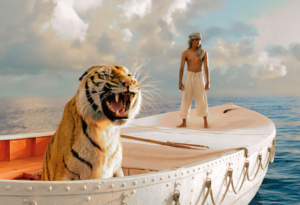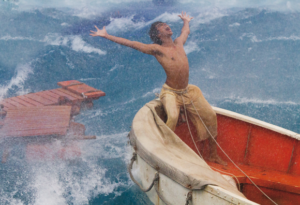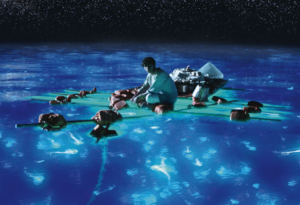From “Gone With the Wind” to “Harry Potter”, beloved bestselling books have been transformed into blockbusters. It is therefore no surprise that filmmakers had their sights set on Yann Martel’s extraordinary novel, “Life of Pi”, as soon as it was published. The book tells the remarkable story of a boy who survives an epic journey across the Pacific with a Bengal tiger after his family perishes in a shipwreck. Oscar winning director Ang Lee has lifted the adventure off the page and onto the big screen to create an engrossing and life-affirming 3D adventure. The movie stands alone, whether or not audiences have read the book.
Hollywood loves a good story. If a book has a powerful narrative, relatable characters and a gripping plot, chances are it will end up on the big screen. Memorable book-based films over the decades have ranged from classics such as The Grapes of Wrath to Breakfast at Tiffany’s. The list is endless. It is interesting that six of the nine Oscar nominated films this year, The Descendants, Moneyball, Hugo, War Horse, Extremely Loud and Incredibly Close and
The Help” were based on popular books. Notable upcoming films inspired by literature include Lincoln, based on Doris Kearns Goodwin’s Pulitzer Prize winning book about the legendary American President, “Cloud Atlas” by David Mitchell and J.R.R. Tolkien’s classic, “The Hobbit”.
The industry’s appetite for both fiction and non-fiction is apparently insatiable, which makes perfect sense to screenwriter Aline Brosh McKenna. “Books have always been a great, renewable resource for Hollywood,” says Brosh McKenna who adapted The Devil Wears Prada from the bestselling novel by Lauren Weisberger, starring Meryl Streep. “If we went down a list of our favorite movies there would be many, many books on them,” she says. “A high percentage of Hollywood movies are adaptations. Original screenplays are harder to get made because when you have a book, you can say ‘This is what we are aiming for’ and that streamlines the process. Time and again people have said, ‘this book is not adaptable’ and then somebody manages to adapt it wonderfully, like Ang Lee in the case of Life of Pi.”
But before Ang Lee signed on for the project, author Yann Martel was far from convinced that his book would make a good film. “When they (Twentieth Century Fox) first talked to me about it I thought they were insane,” Martel laughs. “How can you make a movie out of this story? It’s really complicated. It takes place on water with animals. It is easy to write a sentence like ‘the ship sank’ or ‘there’s a boy in a lifeboat with a tiger.’ but could I imagine the boy and the tiger on the screen in a way that’s credible? No. The novel is essentially very cinematic in the contrast of colors and the beauty of the Pacific, but for technical reasons I did not think it would work. I thought that it would be impossible to translate a 320 page novel into a 210 page screenplay for a two hour film without losing something.” It took a skillfully adapted screenplay by David Magee (Finding Neverland) and the man Martel describes as the “perfect director” before he became convinced that his beloved novel would not be diminished in any way.
“Ang Lee is a brilliant filmmaker who makes wonderful movies,” says the novelist. “I trusted Ang because he’s very versatile and capable. He’s done big movies with special effects like Crouching Tiger, Hidden Dragon. And he is also very good at emotionally nuanced movies like The Ice Storm and Brokeback Mountain.”
Lee certainly had his work cut out for him. The 2002 Man Booker Prize winning novel is very visual with a fantastic, gripping and puzzling plot. The central character is Pi Patel, a teenager who is raised in the Indian town of Pondicherry with his zoo-keeping family. The Patels decide to emigrate to Canada and set off on a freighter with many of their animals. A storm rages in the middle of the Pacific and the boy is hurled overboard onto a lifeboat, together with a hyena, a zebra, an orangutan and a Bengal tiger called Richard Parker. Pi and the tiger survive and embark on a dangerous voyage across the ocean. Because most of the action takes place in the open seas, the book was widely considered to be unfilmable.
Ang Lee relishes a challenge. “I like finding new material to make it harder for myself. I like to tackle things I don’t really know what to do with,” he says. The Taiwanese director has an outstanding track record when it comes to literary films. He transported audiences to 19th century England in his wonderful version of Jane Austen’s Sense and Sensibility and took them to the wilds of Wyoming with his deeply moving Brokeback Mountain, based on the short story by Annie Proulx (which led to an Oscar for Lee).
The director and his team traveled to Taiwan to make the movie. They converted an old airport into a studio and built a giant water tank where much of the sea-faring action was filmed, the tank substituting for the Pacific Ocean. Lee auditioned 3,000 teenagers before casting first time actor Suraj Sharma in the leading role. The film has already been described by critics as ‘beautiful’, ‘magical’ and ‘astonishing’. “I wanted to make a film that the book deserved and it’s been a great adventure,” says Lee.
“As the film became a reality I was totally thrilled,” says Martel. “Pi has been translated into 42 languages. To me the movie is like the 43rd language. And the language of cinema is a universal one, so to have it translated into a film was wonderful. I read the screenplay early on and I gave detailed feedback at a very minute level, but that was my only involvement. I’m a writer not a filmmaker so I let Ang make the movie that he wanted to make,” he says. “The last thing a film director wants, I imagine, is having some author nagging him about what he should be doing. I went on with my life, writing my books and raising my family and so it only became a reality when I stepped into the theater and put on those funny 3-D glasses.”
His final verdict? “It is a visually sumptuous, stunning movie. There is a shocking beauty to the scenes of Pi and the tiger on the lifeboat that will really grab the audience and there are some lovely scenes shot in India. There are many visceral action packed scenes in the film, like the sinking of the ship. But Ang Lee has the genius of telling the story in a leisurely way. He also conveys the complexity of the novel by weaving different elements together and making sense of it. The best thing I think is to forget the book if you have read it and take the movie as an experience on its own terms. It was completely solitary working on the book and to then have this big Hollywood studio take on my movie was weird and it was wonderful. The credits at the end of the film go on forever; hundreds of people worked on the movie.” He smiles. “I take very little credit though. It is Ang’s movie. He deserves all the praise because he’s the one who took all the risks, as did the studio.”
Yann Martel was happy not just with the choice of director but also the screenwriter. It’s the writer’s job to adapt the book, without taking away the essence of the story. While novels generally have a narrative structure, with detailed description, character development and dialogue, the screenplay is usually shorter and involves an entirely different set of skills. “You think about it in a different way I imagine than you do if you are writing a book, so the storytelling is a little different,” explains Aline Brosh McKenna. “The story needs to be compressed and heightened in some instances. Each book has its own landscape that you adapt to, and that’s one of the fun challenges, figuring out what things in the book you know immediately must be in the movie and what to leave behind. I really enjoy screenwriting, it is creatively satisfying,” says Brosh McKenna who has no immediate plans to write a book. “Writing is a lonely business so it’s nice to have a little company working with other people as you do with screenplays.”
According to McKenna, “it makes no difference whether the book is fiction or factual. I don’t worry about which section of the bookstore it is in.” John Grogan, whose bestselling book Marley and Me” became also a succesful film, agrees. “Whether you turn a memoir like “Marley and Me” into a film or a novel in the case of Life of Pi, there is very little difference. The critical factor is that there is a story worth telling with a compelling narrative that touches people intellectually and emotionally.”
Not every literary work leads to a successful or popular film. Many book-lovers visualize their own ‘movie’ as they read and films can diminish the experience. “I know authors who have had their books made into movies and have found it all very discouraging,” says Grogan. “They saw their work reduced by directors and screenwriters who were trying to make something commercial, but ruined the films. However, when a film works, Grogan notes that it can lead audiences back to the original book, or simply offer an alternative version that is equally satisfying. “The Lord of the Rings was a faithful interpretation of the book which I read in high school,” he says. “I was one of those nerdy Tolkien acolytes and I thought Peter Jackson did an amazing job.”
“Great movies like great books will make you think. They have to entertain,” says Yann Martel. “Who wants to read a dull novel? If it’s going to be durable, any good novel has to leave a real impression on the reader. It also has to make people think. It is the same with films. Brokeback Mountain was entertaining but also profoundly moving. You know, blighted love is a tragic topic. That movie made audiences think about the injustice of homophobia and intolerance as well as the sadness that some people have to live with.”
Director Ang Lee relies on his instincts when it comes choosing cinematic books. “I look for books that make me want to jump up and do something with them, to experiment. I look for a book that makes me want to go an adventure with the story. Sometimes it’s just a feeling, the book gets to me in a way that I cannot even describe verbally. Brokeback Mountain is a typical example. It’s a story about gay cowboys in Wyoming. I have no idea what that story has in common with me, but I can tell you that when I read it I was crying at the end. It was unfamiliar but it left a really ‘juicy’ feeling inside of me. When I read that book I really wanted to make a movie and share that experience I had with the audience. It was the same thing with Life of Pi.”
“Great literature has a power that great paintings have and certainly film can have that power too,” concludes Yann Martel. “Audiences will be blown away by the visuals in Life of Pi. It is a great example of the magic of cinema. People will be entertained by it and hopefully they will also be challenged and think about what it all means. It’s a cliché that a picture is worth a thousand words, but in this case, it happens to be true.”
LIFE OF PI
Drama/Adventure, USA 2012 – Directed by Ang Lee
Written by David Magee based upon the novel by Yann Martel
Cinematography by Claudio Miranda Editing by Tim Squyres
Music by Mychael Danna Starring Suraj Sharma, Irrfan Khan,
Rafe Spall, Gérard Depardieu, Adil Hussain
Release December 26, 2012
Distributed by Centfox








